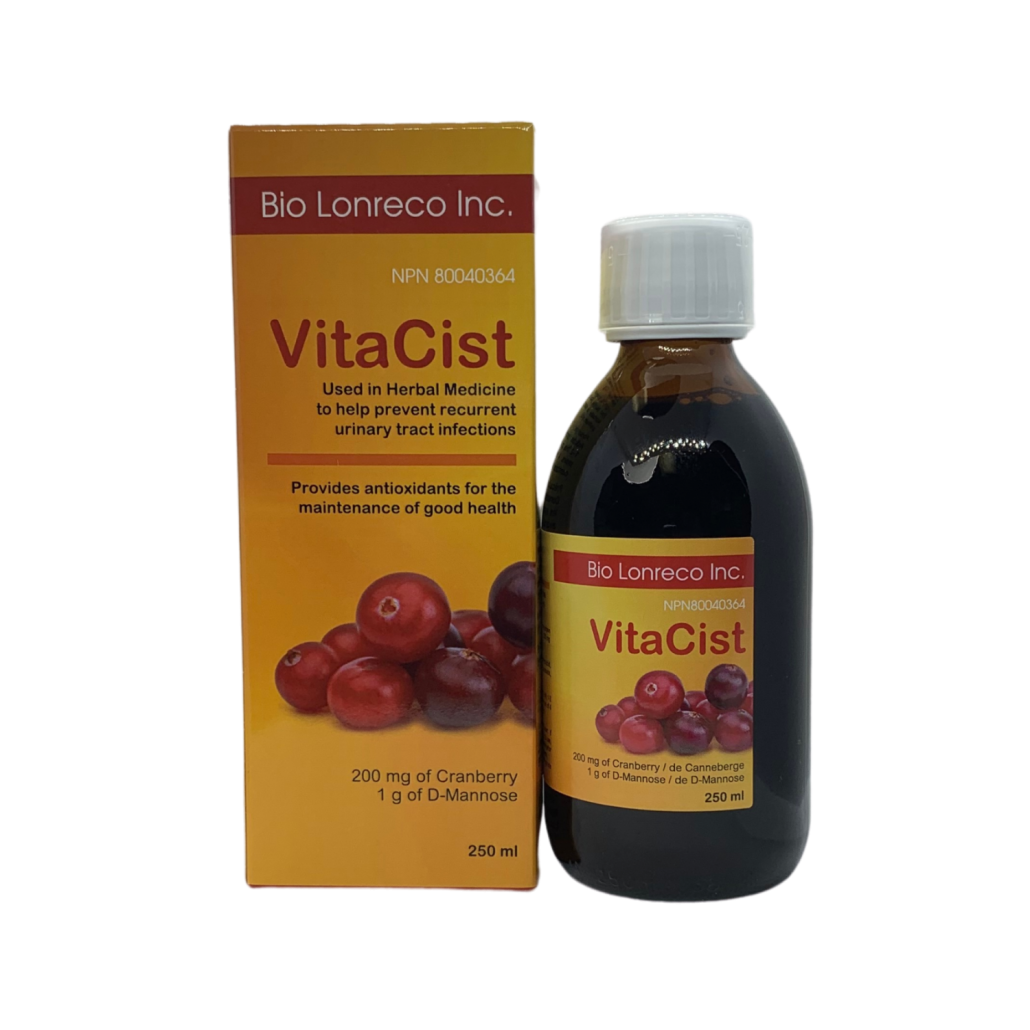Bio Lonreco
VitaCist
VitaCist
Regular price
$35.00 CAD
Regular price
Sale price
$35.00 CAD
Unit price
per
Couldn't load pickup availability
Traditionally used in the treatment of the symptoms of an acute urinary tract infection (UTI). VitaCist can also be used in the prevention of recurring urinary tract infections.
Symptoms of UTIs include:
- Pain or burning with urination
- Frequent urination
- Tenderness and heaviness in lower abdomen
- Fever, chills, and pain in lower back (in severe cases)
Urinary tract infections (UTIs) are some of the most common causes of infections in humans, with women being more affected than men. The signs and symptoms can include, mild frequency to burning and stinging on urination, up to a severe debilitating state of the individual. Another commom problem is the often repeatitive nature of these infections, if they are not addressed properly, initially.
The bacteria that causes most (approximatly 80%) of the recurrent UTIs (also kown as cystitis) is Escherichia coli, a bacteria that is commonly found in the intestines, in a non-pathogenic nature. Due to the proximity, the problems arise when the bacteria travels from the colon to the perianal area and starts to colonize in the urethra or bladder. If the immune system of the individual is strong and there are small numbers of the bacteria, the body will naturally flush them out through the urine, but if the immune system is weak and the enviroment is in favour of the bacteria, they can attach to the membrane linings and proliferate. The bacteria attaches to the urinary tract lining with the help of fimbriae, or filaments. There are two different types of fimbriae receptors that the E. coli produce, one has filaments or “fimbriae-P” and the other has “type-1 fimbriae” receptors. Once the bacteria adhere to the wall, they start to colonize and multiply, hense causing the infection and the UTI symptoms. Both types of filaments have adhesive ability but their structure is slightly different, hence it becomes tough to dislodge them through simple means.
D-mannose, is a sugar that prevents the adhesion of type-1 fimbriae, while cranberries contain proantho-cyanidines (PAC), substances that prevent the fimbriae-P from adhering to the bladder. The combination of cranberry with D-mannose works on the two different types of filaments, thus keeping the bacteria from sticking to the urinary tract, and helping with the prevention of the UTIs.
D-mannose is a simple sugar which is a component of the many polysaccharides found within plants. Around 90% of D-mannose administrated orally is eliminated though the urine within one hour, without being modified by the organism. This property aids in the quick removal of the bacteria and also makes it safe for diabetics, due to its low glycemic index.
When the D-mannose is administered, and as the concentration of the D-mannose in urine optimizes, it helps to blocks “type-1 fimbriae” of Escherichia coli, therefore avoiding bacterial binding to the bladder walls. This process may help to prevent UTIs caused by E. coli, by allowing the quicker removal of the bacteria out of the body, via the urine. If D-mannose is administrated for 4 or 8 weeks after antibiotic treatment, it can prevent the chances of an acute and non-complicated UTIs from turning into a “super infection”.
It is necessary to remember that proper hygiene will assist in the efficiency of the treatment and decrease the chances of reccurance.
Cranberry (Vaccinum macrocarpon L.) native to the cold regions of the Northern Hemisphere, cranberries were traditionally found at the boundaries of the forest, but these days, they are a commonly cultivated crop. The fruit of the cranberry plant is a red coloured berry, when it has matured with a slightly acid taste. Cranberry juice has been consumed for years because of its preventive action on the recurrence of UTIs. Numerous studies have been carried out on the efficiency and efficacy of cranberries in the preventative action on these infections, which repeatedly supports its use for UTIs. Its mechanism of action is based on a component of the berries that acts as a deterrent for the adhesion of the “P-fimbriae” of E. coli bacteria, to the urinary epithelium. This lack of adhesion to the bladder wall by the bacteria, allows for their quicker elimination out through the urine.
The component in cranberries which has this therapeutic effect is Proanthocyanidines (PAC). Proanthocyanidines are a type of flavonoid which assist in the preventive properties of repetitive UTIs. Cranberries contain a specific PAC known as A-linked PAC, which has anti-adhesion properties beneficial in the prevention and treatment of UTIs. Other components of cranberries known as polyphenols and anthrocyanins, have important antioxidant functions, and have also been attributed to its anti-cancerous and anti-infectious properties.
In comparison with the regular formulations, VitaCist contains cranberries together with D-mannose in order to cover a wider spectrum of bladder protection and provide a quicker recovery from the infection. The combined action of cranberry and D-mannose prevents E. coli and other bacteria from colonizing bladder walls, hence avoiding the progression to cystitis.
Supportive remedies
- Dr. Reckeweg: R18, R25
- Tegor: BIO 87, BIO 93, BIO 82
- HerbalGem: G9 IMM-GEM, G32 Vaccinium myrtillus, G56 Juniperus communis, G39 Vaccinum vitis-idaea
- Holistica: Shii•Ta•Ker
- Jardins La Val’heureuse: BIO-BLADDER, BIO-DEFENCE
- Bio Lonreco: MCT Vit D3 1000
Highly absorbable, free of any added preservatives, sweeteners and flavours. Easy-to-use liquid format. Alcohol free.
Ingredients | 5 ml:
Cranberry (Vaccinium macrocarpon L.) (Exocyan Cran 20 S)… 200 mg (50 mg PAC), D-mannose (Birch bark)... 1000 mg
Non-medicinal ingredients: Purified water, citric acid, potassium sorbate, sodium benzoate, Xylitol.
Note: Contains no wheat, gluten, soy, dairy, nuts, eggs, shellfish or any animal by-products.
Dosage
Adults: Take one teaspoon (5 ml) dissolved in a glass of water or unsweetened juice once or twice a day. It is recommended to take it in the evening, before going to bed, so that it can stay active for a longer period of time in the bladder, but dosage can be increased to 2-5 times a day in the case of an acute infection. Use a minimum of 4 weeks to see beneficial results. Shake well before use. Refrigerate once open.
Cautions and Warnings:
Consult a health care practitioner:
- If symptoms persist or worsen
- Prior to use, if you have a history of kidney stones
- Prior to use if you are taking blood thinners
Note: The only side effect associated with D-mannose is the chance of diarrhea, if administered in large dosages.
For more information please consult your health care practitioner.


